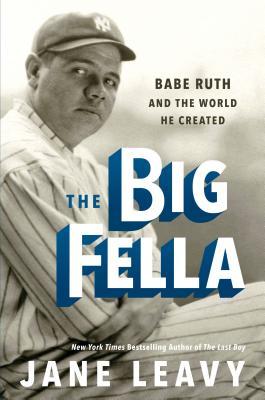
The Big Fella
Babe Ruth and the World He Created
- اطلاعات
- نقد و بررسی
- دیدگاه کاربران
نقد و بررسی

May 15, 2018
The New York Times best-selling biographer of Sandy Koufax and Mickey Mantle, former sportscaster Leavy takes on the biggest baseball legend of all, the man Roger Angell called "the model for modern celebrity." Not just the story of Babe Ruth but of how America came to create its heroes; with a 500,000-copy first printing
Copyright 2018 Library Journal, LLC Used with permission.

Starred review from July 30, 2018
Sportswriter Leavy (Sandy Koufax) energetically narrates Ruth’s larger-than-life story in an entertaining and colorful biography. Troubled by their son’s misbehavior, Ruth’s parents sent the seven-year-old Ruth to St. Mary’s Industrial School for Boys, across town from their home in Baltimore. There, Ruth developed his baseball skills thanks to Brother Matthias, who showed Ruth how to hit. Ruth joined the Baltimore Orioles in 1914, was sold to the Boston Red Sox a few years later, and a year later was traded to the Yankees. In his career Ruth had 2,873 hits, 714 home runs, and a lifetime batting average of .342, and as Leavy points out, Ruth lived as hard as he played; he “imbibed whatever life had to offer.” Ruth’s accomplishments and his appetites for drink and women (he had several extramarital affairs) coincided with the rise of sports journalism and marketing, and his manager, Christy Walsh, was instrumental in creating his public image. In 1927, Ruth slammed his 60th home run of the season, led the Yankees to a four-game sweep of the Washington Senators in the World Series, and embarked on a publicized three-week barnstorming tour of the country with Lou Gehrig to celebrate. Leavy’s captivating biography reveals Ruth as a man who swung his bat with the same purposeful abandon that he lived his life.

August 15, 2018
Does the world need another biography of Babe Ruth (1895-1948)? If it's this one, then the answer is an emphatic yes.The ever excellent Leavy (The Last Boy: Mickey Mantle and the End of America's Childhood, 2010, etc.) brings her considerable depth of knowledge of sports history to her latest project. She also brings considerable empathy for a man who, though notably boorish, at least made an effort to be civilized. Ruth had reason not to be influenced by the world's niceties. After all, as Leavy writes, he was only 7 when his parents sent him to St. Mary's Industrial School for Orphans, Delinquent, Incorrigible, and Wayward Boys on the outskirts of Baltimore. As an adult, he was "six foot two and 215 pounds when he was in trim and made everyone else in uniform look like the boys who later played in youth leagues named for him." He was also decidedly unsubtle: He smashed and hurled and fielded balls with a giant's force, and he "taught America to think big--expect big." Much of the narrative is a fine you-are-there reconstruction of Ruth's big moments, including the 1927 race in which he smacked 60 home runs, led a Yankees four-game sweep of the World Series, and then went off barnstorming with friend and teammate Lou Gehrig. There's tragic inevitability aplenty in that friendship, but Ruth's end in particular, a terrible death to cancer, is particularly jarring. Fans of the latter-day Yankees should wince, too, at Ruth's excoriation of the designated hitter. After another World Series sweep in 1929, Ruth "was back to offering opinions on things he knew about, expressing his disdain for a proposal to add a tenth hitter to the batting order to hit for the pitcher. He said it would take all the strategy out of the game." A skilled strategist and nearly peerless player, Ruth proves himself worthy of, yes, yet another biography, this one warts-and-all but still admiring.Sparkling, exemplary sports biography, shedding new light on a storied figure in baseball history.
COPYRIGHT(2018) Kirkus Reviews, ALL RIGHTS RESERVED.




دیدگاه کاربران